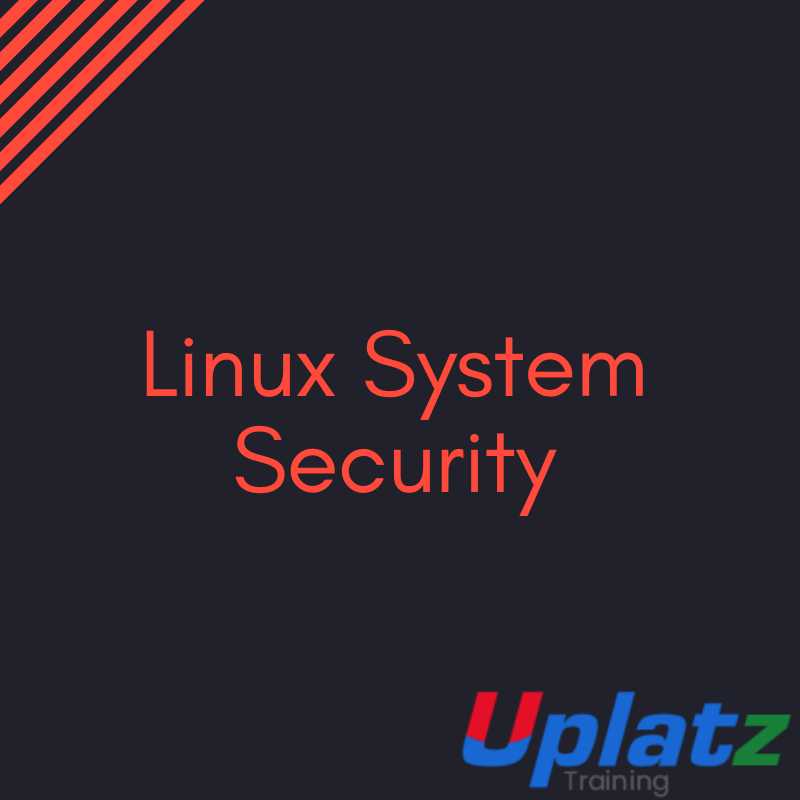Linux System Security

Linux System Security Course Overview
This highly practical instructor led Linux System Security course is aimed at Linux System Administrators who wish to enhance their knowledge of Linux security and increase the security of their Linux systems.
The course is designed to teach security related tasks that would be relevant for many Linux distributions. For the purpose of practical exercises, CentOS Linux will be used.
Exercises and examples are used throughout the course to give practical hands-on experience with the techniques covered.
-----------------------------------------------------------------------------------------------------------------------------------------
Who will the Course Benefit?
The Linux System Security course is aimed at Linux System Administrators who wish to expand their knowledge of the many Linux security features and increase the security level of their Linux systems.
---------------------------------------------------------------------------------------------------------------------------------------
Course Objectives
This course aims to provide the delegate with the knowledge to be able to query their Linux system for most security related events and harden many aspects of their system. The course explains the; Linux logging and auditing framework, SELinux, the firewall, certificate authorities, network time, Secure Shell, Pluggable Authentication Modules, host intrusion and detection, password cracking, the sudo command, encrypting files and OpenVPN.
-------------------------------------------------------------------------------------------------------------------------------------------
This is a Linux System Security course by Uplatz.
Linux System Security
Linux System Security Training Course
Course Introduction
- Administration and Course Materials
- Course Structure and Agenda
- Delegate and Trainer Introductions
Session 1: INTRODUCTION TO LINUX SECURITY
- Linux Native Security
- Areas of Security
- Common Attack Methods
- Basic Security Precautions
- Standards and Compliance
Session 2: SECURING THE USER ENVIRONMENT
- Managing User Accounts
- Bash history
- Configuring History
- Confining User History
Session 3: LOGGING WITHIN LINUX
- Linux Log Files
- systemd Journal
- Linux Audit Framework
- Generating Audit Queries
- Configuring Auditing
- Defining Auditing Rules
Session 4: SELinux
- DAC vs MAC
- The SELinux Policy
- SELinux Contexts
- SELinux Key Commands
- Viewing SELinux Decisions
- SELinux Booleans
- Exporting SELinux Configuration
Linux System Security Training Course
Session 5: SELinux MODULES
- SELinux Entities
- SELinux Modules
- Administering Modules
- Creating Modules With audit2allow
- Writing SELinux Modules
- The Type Enforcement File
Session 6: RED HAT FIREWALL
- Firewalld Overview
- Firewalld vs IPTables
- Firewall Zones
- Configuring Firewall
- Creating a Firewall Service
- Configuring Firewall Zones
- Rich Rules
- Fail2ban Installation and Configuration
Session 7: SECURING SSH
- Key Algorithms
- SSH Agents
- SSH Server Options
- The known_hosts File
- Certificate Based Authentication
- Verifying Signed Certificates
Session 8: SECURING APPLICATIONS
- Certificate Based Authentication
- Creating a Certificate Authority
- Configuring Logging with TLS
- TCP Wrappers
- Network Time
- chrony Security
- Authenticating chrony Clients
Linux System Security Training Course
Session 9: INTRUSION DETECTION AND PREVENTION
- Detecting Intrusions with AIDE
- Installing and Configuring AIDE
- Detecting and Removing Rootkits
- Installing and Configuring ClamAV
Session 10: SECURING PACKAGES
- Red Hat Package Management
- Obtaining Detailed Update Information
- Package Management History
- Creating an rpm Package
- Signing an rpm Package
- Installing a Signed rpm
- Creating a Package Repository
Session 11: PLUGGABLE AUTHENTICATION MODULES
- PAM File Format
- PAM Configuration File
- Using PAM to Allow/Deny a Service
- Restricting Access to SSH
- Increasing Password Complexity
- Delaying Failed Logins
- Controlling Access by Time
- Limiting user Resources
Session 12: CRACKING LINUX PASSWORDS
- Password Hashing Methods
- Verifying Password Strength
- Types Of Password Attacks
- Password Cracking
- Installing a Password Cracking Utility
- Installing a Word List
- Resetting a Lost root Password
Linux System Security Training Course
Session 13: SUDO AND RESTRICTING LOGINS
- Configuring Sudo
- Basic Examples
- Password Administration
- Running Sudo On Remote Systems
- Sudoedit
- Sudo Logging
- Sudo Digests
- Include Statements
- Restricting root Access
Session 14: SECURING THE LINUX FILESYSTEM
- Linux Filesystem Security
- Protecting the Boot Menu
- Securely Erasing Data
- Data Sanitisation Methods
- Extended Permissions
- Extended File Attributes
- File Access Control Lists
- LUKS Encrypted Partitions
Session 15: AN OVERVIEW OF RED HAT IDENTITY MANAGEMENT
- Red Hat Identity Management
- The Identity Management Domain
- IdM Server Configuration Options
APPENDIX A: IdM INSTALLATION
- IdM Server Prerequisites
- Verifying DNS Configuration
- IdM Server Installation
- IdM Client Installation
APPENDIX B: SECURING VSFTPD WITH SSL/TLS
- Creating an SSL Certificate
- Configuring VSFTPD FOR SSL/TLS








